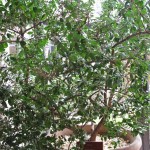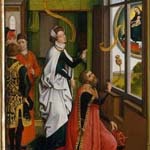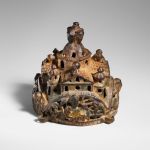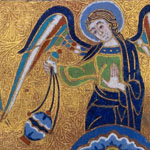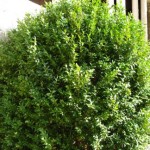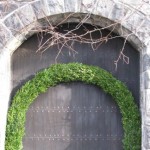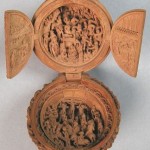Archive for the ‘Fragrant Plants’ Category
Monday, February 1, 2010
Above, from left to right: common myrtle is grown in pots at The Cloisters and brought indoors before frost; detail of the ivory-white blossoms of Myrtus communis; detail of the blue-black fruits of the common myrtle.
In myrtle shades oft sings the happy swain,
In myrtle shades despairing ghost complain.
The myrtle crowns the happy lovers??? heads,
Th??? unhappy lovers’ graves the myrtle spreads.
???Verses Written at The Request of a Gentleman to whom a Lady had Given a Sprig of Myrtle, by Samuel Johnson
This eighteenth-century verse is a deft summation of many centuries of the myrtle???s association with love, lovers, and the goddess of love. Read more »
Tags: Esther, herb, Hippolytus, love, myrtle, myrtus communis, Ovid, Pausanias, perfume, Phaedra, Pliny, Samuel Johnson, unguent
Posted in Food and Beverage Plants, Fragrant Plants, Gardening at The Cloisters | Comments (2)
Friday, January 8, 2010
Above, from left to right: Detail from a fifteenth-century panel of The Nativity that shows the Emperor Augustus censing an??apparition of the Virgin and Child; cover of a gilded copper censer in The Cloisters Collection (1979.285); Detail from Panel with Censing Angels, on display in the Treasury at The Cloisters.
The ceremonial use of incense in devotions and rites of purification?? is common to many religious traditions?? and dates back to antiquity. (The incense trade was of great economic importance.)?? While some animal substances such as ambergris and musk are used, most incenses are of botanical origin. Read more »
Tags: bdellium, Commiphora africana, Commiphora myrrha, frankincense, incense, myrrh
Posted in Fragrant Plants, Gardening at The Cloisters | Comments (0)
Friday, December 18, 2009
Above, from left to right: Boxwood shrub growing in Bonnefont Garden; fresh boxwood installed on the Main Hall arches for the holidays; detail view of a minutely carved boxwood rosary bead in The Cloisters collection. See the Collection Database to learn more about this work of art.
Boxwood (Buxus sempervirens) is most familiar to us as a foundation planting, or as a low edging for garden beds, a practice that became common in the sixteenth century and continues today. Boxwood has also been a popular subject for topiary work since Roman times. There are many varieties of box, including dwarf forms and forms with variegated foliage. (For more about B. sempervirens and other ornamental species, visit the website of The American Boxwood Society.) Read more »
Tags: boxwood, Buxus sempervirens, yew
Posted in Fragrant Plants, Medicinal Plants, Useful Plants | Comments (2)
Friday, May 15, 2009
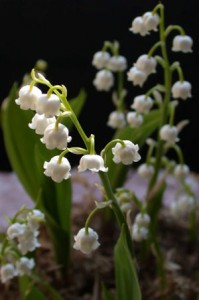
Above: Lily of the valley (Convallaria majalis)
White coral bells upon a slender stalk
Lilies-of-the-valley deck my garden walk. . . .
???Traditional English Round
In spite of its medieval association with the exotic Queen of Sheba (see last week’s post), this modest, northern European woodland flower is actually as easy to grow as it is familiar. Read more »
Tags: Convallaria majalis, lily of the valley
Posted in Botany for Gardeners, Fragrant Plants, Gardening at The Cloisters, Medicinal Plants, Plants in Medieval Art | Comments (7)
Friday, February 27, 2009
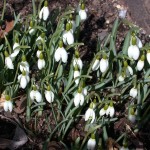
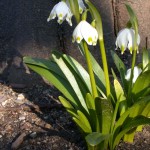
Left:??The snowdrops (Galanthus nivalis) under the quince trees in Bonnefont Cloister bloom from February to March, while snowdrops in warmer climates may flower as early as January; right: the closely related spring snowflake (Leucojum vernum) blooms from March to May.
The winter-blooming snowdrop and spring snowflake appear so closely related that the great sixteenth-century herbalist John Gerard named them the Early Blooming Bulbous Violet and the Late Blooming Bulbous Violet. Read more »
Tags: Galanthus, Leucojum, Mary plant, snowdrop, snowflake
Posted in Fragrant Plants, Gardening at The Cloisters, Plants in Medieval Art | Comments (2)
Friday, January 23, 2009
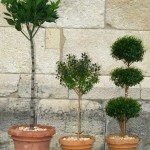
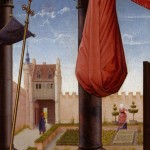
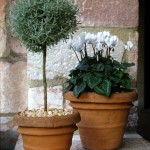
Above, from left to right: Topiaries in the plant collection at The Cloisters; detail from The Annunciation, 1465???75, Workshop of Rogier van der Weyden (possibly Hans Memling, active by 1465, died 1494) (Netherlandish, 1399/1400???1464), The Metropolitan Museum of Art, New York, Gift of J. Pierpont Morgan, 1917 (17.190.7); cotton lavender topiary in Cuxa Cloister.
Medieval topiary was relatively simple and non-representational. Woody plants were trained to standards topped by balls, or to a characteristically medieval form known as an estrade, in which the plant was grown in tiers. Although these are rarely represented before 1400, many fifteenth-century artworks show estrades and other simple, geometric forms growing both in pots and in garden beds. The more ornate representational topiary known to the Romans was revived in Renaissance Italy; the Rucellai garden in Florence, created in the second half of the fifteenth century, included animals and human figures, as well as topiary temples and urns.
The practice of artfully clipping and training woody plants into formal or fanciful shapes can be traced back to imperial Rome and the Natural History of Pliny the Elder, who attributes the relatively recent invention of nemora tonsilia or “barbered groves” to one Gaius Matius, a Roman knight and a friend of the Emperor Augustus (John Boardman, The Oxford History of the Roman World, 2001). Read more »
Tags: bay, cotton lavender, estrade, herb, Laurus nobilis, Myrtis communis, myrtle, rosemary, Rosmarinus officinalis, Santolina chamaecyparissus, topiary
Posted in Fragrant Plants, Gardening at The Cloisters | Comments (6)
Friday, November 21, 2008
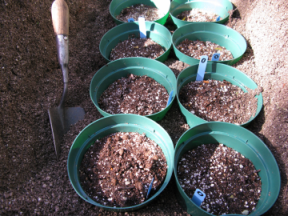
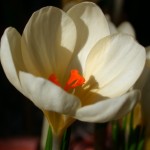
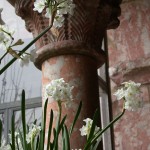
Above, from left to right: Forced bulbs in coldframes at The Cloisters; Crocus chrysanthus ‘Cream Beauty’; Narcissus tazetta ‘Inbal,’ (paperwhites) in Cuxa Cloister.
Every year, by the time February approaches I have the winter doldrums and the beauty of spring is long forgotten. The days become shorter, darker, and extremely colder. It is at this time that my senses need to be reminded why I ever decided to become a gardener. Forced spring bulbs during the winter months provide that reminder wonderfully. Just when I think there is no possible way to endure another day of winter, the first pot of forced paperwhites, Narcissus tazetta, is unveiled at The Cloisters.
Read more »
Tags: Bulbs, Crocus, Fritillaria, Hyacinth, Narcissus, Paperwhites
Posted in Fragrant Plants, Gardening at The Cloisters | Comments (0)
Monday, October 27, 2008

Above: Ripe quinces in late October.
The famous quince trees that grace the four beds at the center of the Bonnefont Cloister Herb Garden have grown there since the early 1950s. Although the trees are showing their age, they still bear a heavy crop???so heavy that it is necessary to thin the fruits in late summer and to prop up the aging boughs to help them to bear the weight of the fruit. The quinces are not harvested; the fruits are picked up as they fall. Read more »
Tags: Cydonia oblonga, fruit, quince
Posted in Food and Beverage Plants, Fragrant Plants, Gardening at The Cloisters, Medicinal Plants | Comments (11)
Thursday, October 2, 2008

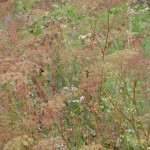
Left: Anise (Pimpinella anisum) in flower, Bonnefont Herb Garden; right: Anise (Pimpinella anisum) in seed, Bonnefont Herb Garden.
Representatives of the Apiaceae family are scattered throughout all of the gardens at The Cloisters, but they are most prominent in the culinary beds of Bonnefont Herb Garden. These plants are greatly exploited for their distinct fragrances and tastes. The essential oils, created from a fairly large group of chemical constituents within the plants, are responsible for the incredibly flavorful and aromatic properties of this family. In addition, these properties help to ensure the survival of plants in this family by attracting pollinators to the flowers. Read more »
Tags: Apiaceae, Culinary Herbs, Fennel, Fragrant Herbs, herb
Posted in Botany for Gardeners, Food and Beverage Plants, Fragrant Plants | Comments (5)
Friday, September 19, 2008


Left: Angels offer a basket of jasmine and roses to the??Madonna and Child; right: detail of a basket of jasmine flowers and single-petaled white roses.
Jasmine’s significance as a symbolic flower blossoms in the art of the Italian Renaissance, where it appears as a symbol of divine love and heavenly happiness.?? In combination with roses and lilies, which have a much longer iconographic history in Western art, it often appears in representations of the Madonna and Child.?? Attendant angels offer jasmine to the infant Christ, or are wreathed with crowns of jasmine themselves. (Mirella D’Ancona Levi, The Garden of the Renaissance:?? Botanical Symbolism in Italian Painting, 1977.)
Although it was grown in the Islamic gardens of southern Europe as early as the twelfth century, jasmine was not established in northern European gardens until the close of the Middle Ages.?? Jasmine and roses scented the garden walks of the mid-fourteenth-century villa (believed to be the Villa Palmieri, two miles southeast of Florence) described by Bocaccio in the Decameron, but the earliest conclusive proof of jasmine’s presence in France is an illuminated border produced by Jean Bourdichon for the Great Hours of Anne of Brittany, c. 1501???1507. (John Harvey, Medieval Gardens, 1981.) Jasmine is intensively cultivated to this day at Grasse, which has been the center of the French fragrance industry since the Middle Ages. The English herbalist William Turner reported that jasmine grew abundantly in gardens around London by 1548. Read more »
Tags: jasmine, Jasminum officinale, perfume
Posted in Fragrant Plants, Medicinal Plants, Plants in Medieval Art, The Medieval Garden | Comments (5)
